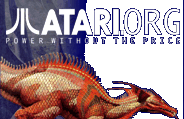| Subject: RE: Ideas on new Atari |
Author: Evan Langlois (c-67-164-129-171.client.comcast.net)
Date: 03-04-2005 00:54
Yes, I'd forgotten that Atari named what would simply be an IO chip an "MMU" and MMUs had been around for awhile already, its hardly a new use of the term - they just misused it. And yes, its totally transparent to software as you said, as most of the custom chips should be.
Frankly, I don't see the point in 100% compatibility for programs that access hardware directly - supporting a bad practice with another bad practice just to continue using outdated hardware at a higher price doesn't make sense at all. Might as well keep using the original hardware. Supporting clean programs 100% and other stuff through emulation makes for a better transition.
100% emulation on modern hardware doesn't make sense to me either. I have plenty of software for my computers and the capabilities are wonderful. Nor am I plagued by MicroSoft - I run 100% Linux, and I'm a Unix Admin, so I'm more than qualified to make excellent use of every piece of the OS - not that Gnome is any harder to use than an ST, but it certainly takes some extra horsepower to run Gnome.
Now, a lightweight, possibly portable device that doesn't have the long boot times and relatively high maintenance requirements of modern systems that can be amazingly fast on relatively cheap hardware ... now that can be interesting. I'm not talking about making a desktop out of a 20 yr old architecture.
I do see a potential for an embedded system with an excellent existing software base. Hell, the M5475EVB evaluation board has support for an 800x600 12" touchscreen. Its only 64MB of RAM and a 16MB flash, but how much Atari software can you fit in 16MB? Isn't 64MB enough for an ST? And with USB, PCI, ethernet, etc, its would make a very nice portable platform. It has a real MMU, and although most ST software doesn't make use of it, it would enable hardware emulation. I see a possibility where initial testing can be done by actually having a virtual machine for the OS to load on, and you can choose ST or Amiga or Linux/68K (or maybe even NeXT) to load into the machine. You could even have multiple OSs co-existing if you have more RAM.
Already Linux and other stuff are ported and the ACP has been working with an earlier board and got MiNT to load. They are working towards a different design with hardware level compatibility since older Coldfires didn't have an MMU, but the work required to just get the evaluation board running a full TOS should be fairly minimal excluding hardware emulation, which shouldn't take all that much additional work if they switch to the new 4e designs with an MMU. They even have a 68K -> Coldfire assembly converter (free) so you can translate programs and reassemble them without emulation.
|



